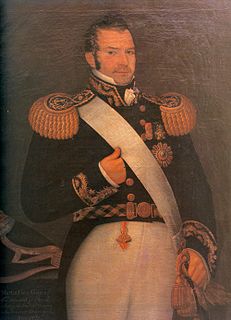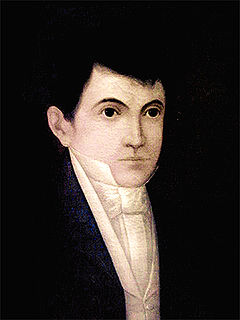 W
WSebastián Ágreda was Bolivian general who served briefly as the de facto 7th President of Bolivia for 29 days in 1841. In addition to his short term as president, he also held a number of other governmental roles as well as being a prominent figure in the Bolivian military.
 W
WJorge Beauchef was a French military who participated in the Napoleonic Wars and later on in the Chilean Independence War.
 W
WPedro Blanco Soto was a Bolivian general and politician who served as the 5th President of Bolivia for just one week from 1828 to 1829 cut short by his assassination in a convent called La Recoletta in Sucre on New Year's Day 1829. He was shot on the roof above a stairwell while attempting to escape. A small plaque now marks the spot in the Museo de la Recoletta. He was well known for his pro-Peru stance and this is generally the reason attributed to his assassination.
 W
WSimón José Antonio de la Santísima Trinidad Bolívar y Ponte Palacios y Blanco, also colloquially as El Libertador, or Liberator of America was a Venezuelan military and political leader who led what are currently the countries of Venezuela, Bolivia, Colombia, Ecuador, Peru, and Panama to independence from the Spanish Empire.
 W
WJosé de Canterac was a Spanish general of French origin who fought in the Spanish American wars of independence. In 1816 he joined the army of Pablo Morillo, fighting in the expedition against Isla Margarita. As Field Marshal, he took command of the Spanish Army in South America in 1822 and gained victories at the battles of Ica (1822) and Moquegua (1823). His defeats in 1824 at the Battle of Junín and the Battle of Ayacucho led to his capitulation to the Patriot forces. Upon his return to Spain, Canterac was made Captain General of Madrid. He was killed in 1835 in an insurrection at the Puerta del Sol.
 W
WJonas Halstead Coe, sometimes given in Spanish as Comodoro Juan Coe, was an American-born naval commander, notable in the early naval history of Argentina and Uruguay.
 W
WValentín Ferraz y Barrau was a Spanish military commander and politician. After fighting in the Peninsular War and in the Peruvian War of Independence Valentín engaged in the chaotic politics of the post-war reign of Isabella II of Spain, serving as Prime Minister of Spain in 1840 and holding other important offices such as Mayor of Madrid.
 W
WGeneral José Francisco Gana López was a Chilean military and political figure, who took part in the Peruvian War of Independence. José Francisco Gana was of Basque descent.
 W
WMartin George Guisse, born Martin George Guise, and later known as Jorge Martín Guisse in Spanish, was a British naval officer who served in Royal Navy in the French Revolutionary and Napoleonic Wars. He later served in the Chilean Navy during the Peruvian War of Independence and, as Vice-Admiral, in the Peruvian Navy in the Gran Colombia–Peru War, during which he was killed.
 W
WPedro Alcántara Herrán Martínez de Zaldúa ) was a Colombian general and statesman who served as President of the Republic of the New Granada between 1841 and 1845. As a general he served in the wars of independence of the New Granada and of Peru.
 W
WJusto Apu Sahuaraura Inca was an Incan noble and a leader of Peruvian independence. He was the son of Pedro Sahuaraura Tito Atauchi, chief of the Quispicanchi, and descendant of Paullu Inca and, through him, a descendant of Huayna Cápac.
 W
WJosé Domingo de la Merced de la Mar y Cortázar was a Spanish and later Peruvian military leader and politician who served as the second and eighth President of Peru.
 W
WFrancisco Xavier de Luna Pizarro was a Peruvian priest, politician and lawyer. He served as Archbishop of Lima from 1846 to 1855, deputy for Cusco and Arequipa, and President of the Constituent Congresses of 1822, 1828 and 1834.
 W
WMariano Lorenzo Melgar Valdivieso was a Peruvian revolutionary, poet, artist, translator and patriot soldier during the Peruvian War of Independence from Spain. As a poet, Melgar became one of the most prominent romantic poets of Peru in the 19th century history, best known for his poetic love songs known as yaravíes. He is often considered to be the equivalent of the Ecuadorian José Joaquín Olmedo and the Cuban José Martí as patriots of their respective countries.
 W
WMariano Necochea was an Argentine-Peruvian soldier.
 W
WManuel Olaguer Feliú, was a Spanish military engineer known for his role in constructing and overhauling fortifications in Colonial Chile as well as his later participation in the Chilean and Peruvian wars of independence. Upon his return to metropolitan Spain he was promoted to the rank Field Marshal and became Captain General of Galicia.
 W
WJosé Silverio Olaya Balandra was a Peruvian hero in the Peruvian War of Independence.
 W
WJoaquín de la Pezuela y Sánchez, 1st Marquess of Viluma, (1761–1830) was a Spanish military officer and viceroy of Peru during the Peruvian War of Independence.
 W
WMateo García Pumacahua simply known as Pumacahua, modern spelling variants Pumakawa or Pumaqawa was a Royalist commander later turned into a Peruvian revolutionary who led the Cuzco Rebellion of 1814 in the War of Independence.
 W
WJosé Francisco de San Martín y Matorras, known simply as José de San Martín or the Liberator of Argentina, Chile and Peru, was an Argentine general and the primary leader of the southern and central parts of South America's successful struggle for independence from the Spanish Empire who served as the Protector of Peru. Born in Yapeyú, Corrientes, in modern-day Argentina, he left the Viceroyalty of the Río de la Plata at the early age of seven to study in Málaga, Spain.
 W
WAntonio José de Sucre y Alcalá, known as "Gran Mariscal de Ayacucho", was a Venezuelan independence leader who served as the 4th President of Peru and as the 2nd President of Bolivia. Sucre was one of Simón Bolívar's closest friends, generals and statesmen.